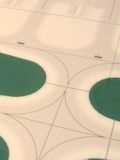|
Home |
Pavements Pavement sheets are available for free download in 1:400 and 1:500 scales, and they can be purchased ready-printed. All of the pavement sheets only include the actual pavement. Other areas, such as grass between taxiways is not included. The baseboard should be prepared by painting, or otherwise covering, all the areas between the pavement sheets. Pavement sheets can be downloaded and printed on any suitable paper type. It is best to use a relatively thin paper, rather than thick card (we have used Epson Photo Quality Ink Jet Paper at 102gsm in our displays). Specialist water-proof and tough papers can be used, to give a more durable surface, but these are extremely expensive. The surface can be varnished or covered with a protective spray after construction, if necessary. If possible, use a printer that maintains the correct size of the printed sheets (some printers are not good at printing at the actual size). Also make sure that the printed output is "square" (ie the same size both horizontally and vertically). The square concrete blocks can be used to check this. On some of the sheets the printed area comes close to the edge of the page, so a printer that can print with small margins is preferable. The pavement sheets all download as PDF documents and require the Adobe Reader program to view them. To print from Adobe Reader, select the Print icon and ensure that Page Scaling is set to None (Zoom 100%). We have used 6mm MDF as the base boards for our displays, but other materials are also suitable. Use board that is perfectly flat, with a good surface that will take adhesive, and take care not to allow them to warp when stored. Take care when storing, to make sure that the boards, and any models fixed to them, are not damaged. If you need to split a diorama into a number of sections (as we have) then plan the joins between boards so that they correspond with the joins between sheets, as far as possible. It may also be necessary to cut some sheets into two where the boards meet. We used a spray-mount type of adhesive to glue the pavement sheets in place, and some customers have found that wallpaper paste works well. A glue that allows repositioning before it finally sets is best. Make sure that the edges are stuck down well and don't peel up. Use the printed markings to make sure that each sheet aligns perfectly with its neighbours. As with all
models, test the fit of each part and trim if necessary before gluing
into place. A sheet of general instructions for building pavement sets can be downloaded (in PDF format) by clicking here. |
|
This document is maintained
by DM Aviation Limited
All Material Copyright © DM Aviation Limited 2011




